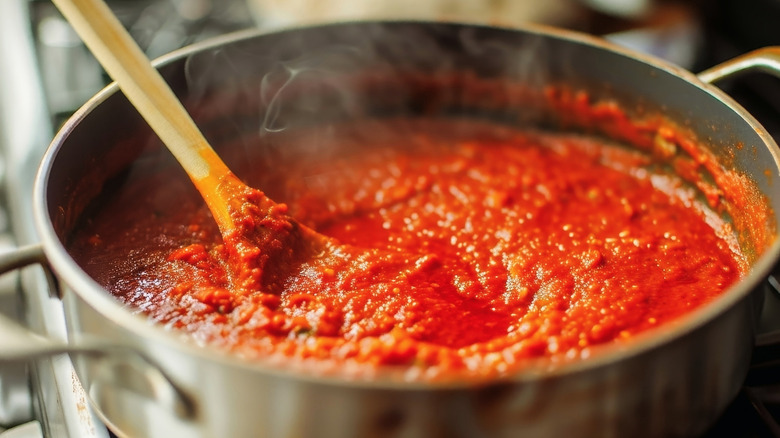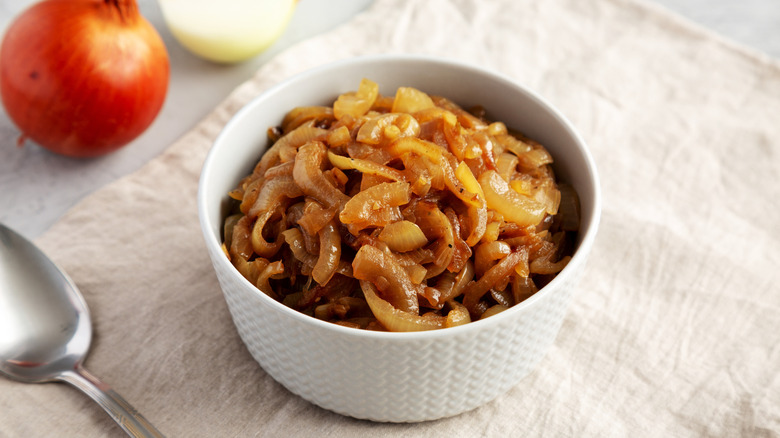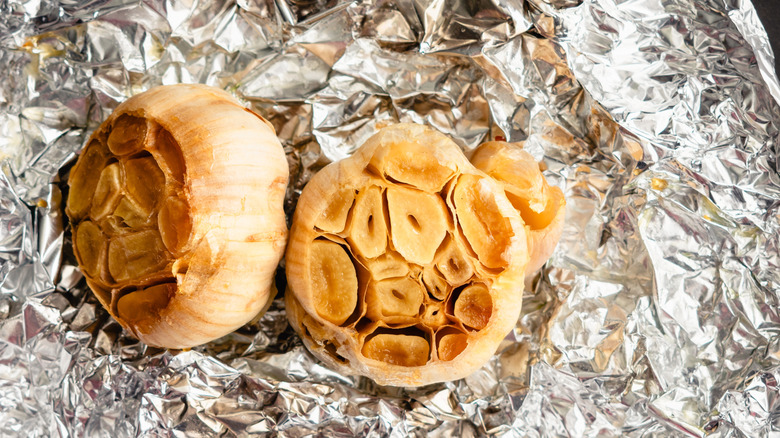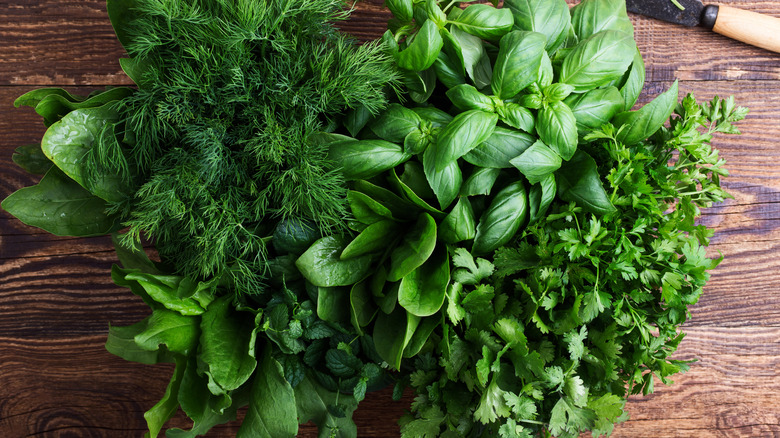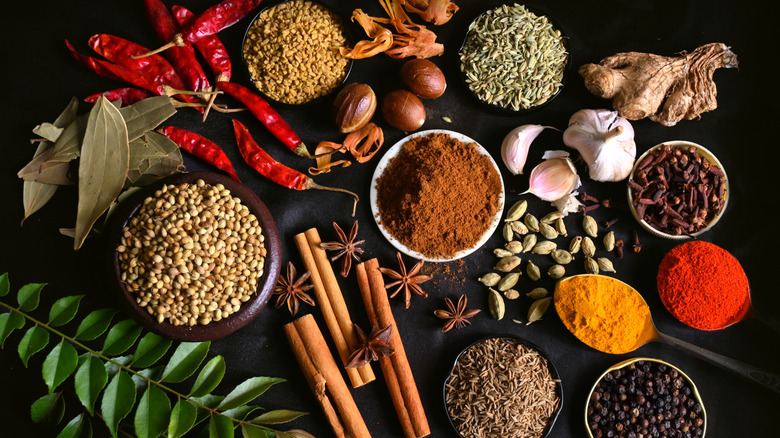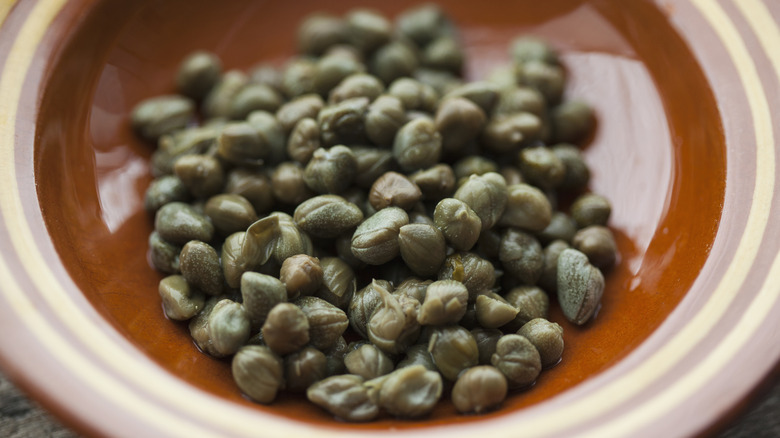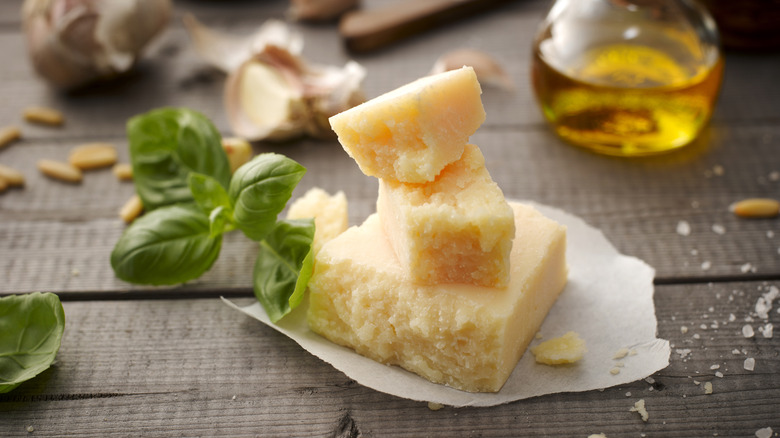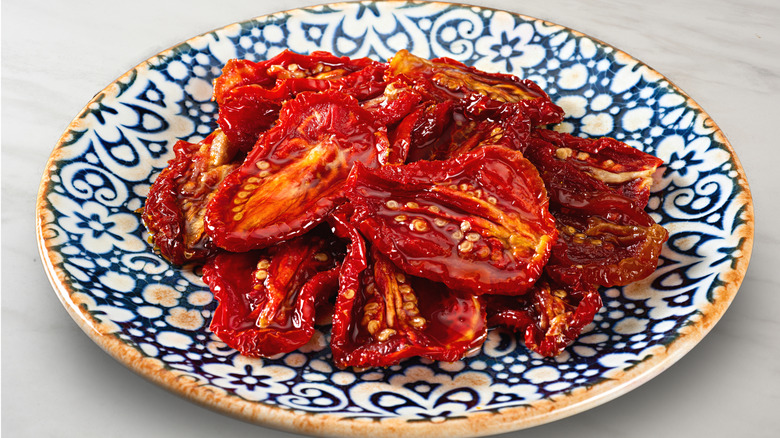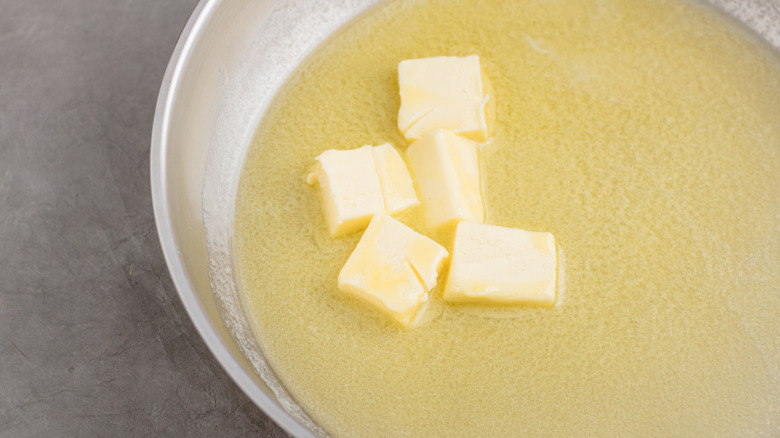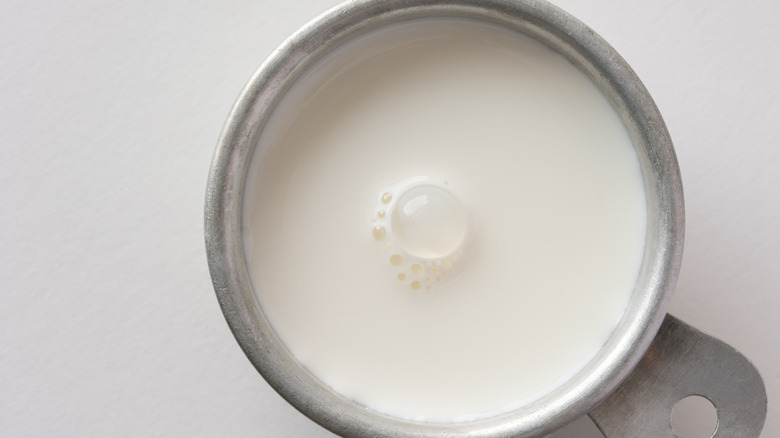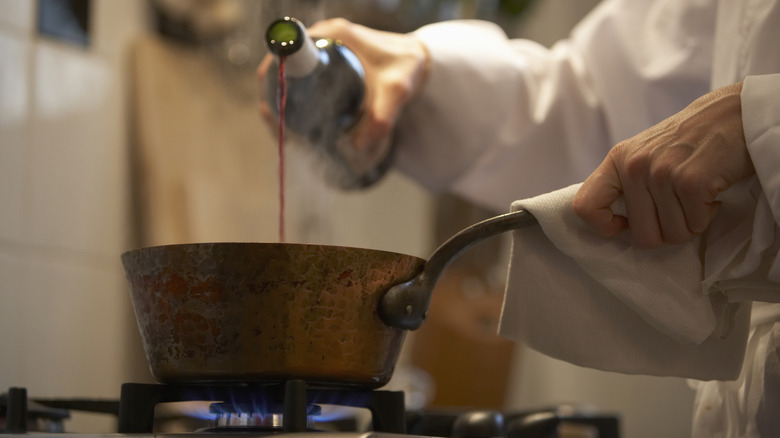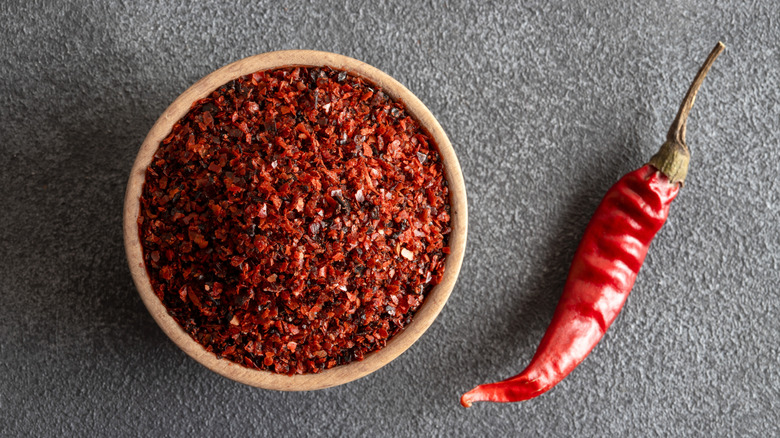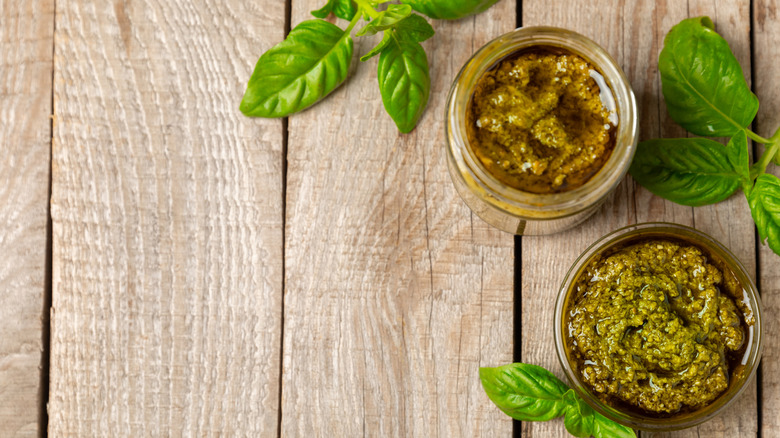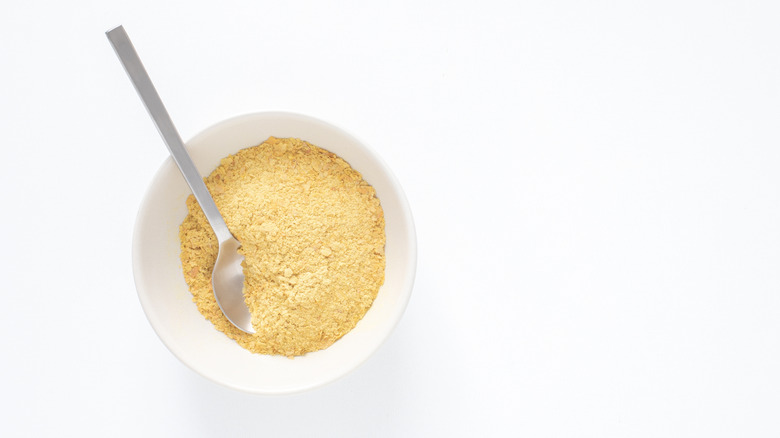14 Ways To Give Store-Bought Pizza Sauce A Serious Flavor Boost
Sometimes you want the rich, vibrant flavor that makes homemade pizza as incredible as it should be, but you don't always have the time to whip up a batch of sauce from scratch. Store-bought pizza sauce is convenient, but sometimes it tastes a little flat. Luckily, a few tweaks can transform a jarred sauce into something bold and flavorful that will do your dinner justice.
You don't need fancy ingredients or hours of simmering, it's totally possible to make supermarket pizza sauce taste almost as good as homemade. You just need to know how. I used to sling pies professionally, so I've made gallons of sauce and know what makes it taste great.
I've borrowed some top-notch techniques for tasty pizza sauce from my favorite homemade versions, including the recipe my nonna taught me. Using these same techniques can make store-bought versions taste pretty much like they came from a pizzeria in Firenze. Yes, it might take a little longer than cracking open a can but it's still simpler than making sauce from scratch.
1. Cook it with olive oil
One of the simplest ways to elevate store-bought pizza sauce is by giving it a quick sauté in olive oil. Most of these sauces are raw when they go on the pie, cooked only once in the oven along with your pizza. While this approach is many people's preferred option, there's a reason why you should try cooking your pizza sauce.
Cooking it twice (once in the pan and once on your pie) intensifies the flavors, deepens the natural sweetness of the tomatoes, and mellows out any harsh acidity. Plus, the olive oil adds extra richness and flavor that makes the sauce taste homemade, even if you know it's not.
To try this, heat a couple of tablespoons of good-quality olive oil in a skillet over medium heat. When it's shimmering, pour in your sauce and let it simmer away for 5 to 10 minutes. If you want, you can chuck in some garlic or chili flakes as the oil heats for an extra layer of flavor. Just this little bit of time makes a big difference to the finished sauce.
2. Caramelize some onions
Caramelized onions can give store-bought pizza sauce a real flavor boost. Jarred sauce may contain onions but it usually just has garlic for flavor. That's why adding onions, particularly caramelized ones, makes such a difference. Their natural sweetness and deep savory flavors can make pizza sauce taste homemade.
Caramelizing onions is easy but it requires a bit of patience. There are tips to get perfectly caramelized onions every time that can help too. Start with a couple of medium yellow or sweet onions and slice them thinly. Heat a generous drizzle of olive oil in a skillet over medium heat. Add the onions along with a pinch of salt to draw out their moisture. Stir occasionally as they soften and slowly take on a deep golden-brown color.
This process usually takes around 30 minutes, but it's worth it. If the onions start to stick, add a splash of water to loosen everything up and keep them cooking evenly. Once they're done, stir them into your pizza sauce and you're ready to make a pie.
3. Mash in some roasted garlic
Roasted garlic is a game-changer for jarred pizza sauce. Unlike raw garlic, which can be sharp and pungent, roasted garlic is soft, mellow, and slightly sweet. It's a whole different beast. And it can make grocery store sauce taste more like homemade versions.
What's great about roasted garlic is that its soft texture makes it easy to mash and mix through a jar of ready-made sauce. The sweetness of the garlic balances the acidity of the tomatoes, while its creamy texture gives the sauce a velvety finish. It's a simple way to level-up your sauce and make it feel gourmet with minimal effort.
If you're not sure how to roast garlic, we've got you covered. Take a whole bulb, slice off the top to expose the cloves, and drizzle it with olive oil. Wrap it in foil and roast at 400 F for about 40 minutes, until the cloves are golden and buttery soft. Once the bulb is cool enough to handle, squeeze the cloves out of their skins, mash them, and mix them into your sauce, tasting as you go until the flavor is just right.
4. Use fresh herbs
Fresh herbs are among the easiest and most effective ingredients you can use to boost the flavor of store-bought pizza sauce. Jarred sauces usually already have dried herbs in them, but they can taste muted or one-dimensional. Adding fresh herbs lifts the flavor and makes it closer to homemade versions. What's more, they're readily available — you might even have some growing on your kitchen windowsill.
Basil is a classic choice for pizza sauce, as it pairs beautifully with tomatoes. Oregano is another great option, and is way more complex than the dried stuff you'll find in grocery store sauces. Thyme, sage, and rosemary are also winners, adding a savory depth that's perfect for heartier pizzas.
One of the mistakes people make with fresh herbs in sauce is overloading it with too many different varieties at once. Stick to two or three to keep the flavors balanced. Also, be sure to chop the herbs finely so they're evenly distributed. No one wants to bite into a big chunk of woody rosemary. It might seem like a basic addition, but a fistful of fresh herbs can leave you with a sauce that does your homemade pie justice.
5. Add Indian spices
Leftover curry makes an excellent pizza sauce, but you can also recreate the effect with store-bought pizza sauce. Adding Indian spices is a delicious way to whip up a fusion pizza. It works particularly well for pizza sauces that are light on the herbs and coexist with your choice of spices.
Spices like garam masala or curry powder transform the sauce from Italian-inspired to Indian-inspired. Curry paste is another great option, offering a concentrated hit of spices along with aromatic ingredients like garlic and ginger. This kind of spiced up sauce works well with toppings like chana masala, paneer, roasted cauliflower, and a drizzle of cooling raita for contrast.
If you want to doctor your sauce in this way, heat some oil and sprinkle in about a teaspoon of garam masala or curry powder, or a tablespoon or two of curry paste. Cook it for a minute or two to let the spices bloom, then add the pizza sauce and cook it a little longer until the flavors meld. You can adjust the quantity of spices to tailor it to your preferences.
6. Incorporate capers
You can give supermarket pizza sauce a bright, tangy punch by adding capers. These little green buds are salty and briny in a way that cuts through the richness of tomatoes. They're perfect for pairing with toppings like olives, artichokes, and fresh mozzarella.
To incorporate capers into your sauce, you have a few options depending on the texture and flavor you're after. If you like bold, concentrated bursts of flavor, stir in a spoonful of whole capers before topping your dough. If you want them more integrated into the base, finely chop them before mixing them in. This way, you'll get flavor throughout the sauce without it dominating. Or, for a totally smooth sauce, blend the capers directly in with the other ingredients.
Just be mindful of salt when using capers. Since they're naturally salty, taste your sauce as you go and make sure not to overdo it. If you accidentally use too many capers, you can add extra tomato sauce or tomato paste to balance it out.
7. Mix in some Parmesan
Parmesan isn't only for sprinkling on top of your pizza. It also tastes amazing stirred right into the sauce. This hard, aged cheese adds a deep umami richness that instantly makes store-bought offerings taste more complex and like they were made from scratch. Its nutty, salty flavor contrasts and enhances the natural sweetness of tomatoes.
To incorporate Parmesan, start by grating it finely. This helps it melt quickly and evenly. Stir a few tablespoons of cheese into warmed pizza sauce, letting it blend in as the sauce heats. Ideally, you should choose real Parmesan for the best flavor. Pre-grated options just aren't the same.
That said, it doesn't have to be Parmesan. Other Italian hard cheeses are great additions. Pecorino Romano or pecorino Sardo are both delicious in pizza sauce. Alternatively, just use whatever you have kicking around in the fridge. Cheddar, blue cheese, edam, jack — they can all add richness and flavor to your sauce. It might seem like overkill, as you're going to be putting cheese on top of your pizza, too. But you don't have to add a lot. Just enough to intensify your sauce.
8. Add sun-dried tomatoes
Adding sun-dried tomatoes to jarred pizza sauce is an easy way to amplify its flavor, bringing in a concentrated tomato intensity with a subtle sweetness. They infuse umami notes and an aromatic twist that regular tomatoes alone can't match.
When shopping, you'll find two main types: oil-packed and dehydrated. Oil-packed tomatoes are soft and ready to use straight from the jar. Their oil, often infused with garlic or herbs, can also add extra flavor. Dehydrated sun-dried tomatoes need a quick soak in hot water or broth to rehydrate them before use. However, they have a slightly deeper, more intense flavor once softened.
You can chop oil-packed sun-dried tomatoes into small pieces and stir them directly into your sauce before spreading it on your base. For a smoother texture, blend a few into the sauce with some of their oil for added richness. If you're using rehydrated tomatoes, dice them finely or puree them before mixing them in. Either way, prepare for some richly tomatoey goodness.
9. Melt in a knob of butter
Melting butter into store-bought pizza sauce is a simple trick that makes a big difference. Butter adds a richness that other ingredients just can't match. While it might seem like olive oil is the obvious choice of fat to use, hear us out on this one. It's the kind of upgrade that makes you wonder why you weren't doing it all along.
For an even deeper flavor boost, try browning the butter before adding it to the sauce. Browned butter is made by gently heating butter until the milk solids toast and turn golden brown. It gives the butter a nutty flavor that tastes amazing in sauces. To brown butter, all you have to do is melt it in a saucepan over medium heat, swirling it occasionally until you see golden flecks and smell a nutty aroma. Then, remove it from the heat right away to avoid burning.
Once your butter is ready, stir a tablespoon or two into your sauce. It might not make a dramatic change to the flavor, but it definitely adds something. Mixed with all the other pizza ingredients, you wouldn't be able to pick out butter as an ingredient, but its rich flavor and texture boost things to the next level.
10. Add heavy cream
You can easily give your grocery store pizza sauce a flavor boost with the help of heavy cream. It softens the sharp acidity of the tomatoes and gives it a creamy finish that's more like a gourmet recipe than something straight from a jar. If you're looking for ways to make your pizza richer, this will do it.
To incorporate heavy cream, simply stir a few tablespoons into the contents of your jar. Too much can make the sauce too thin to work with, but too little won't give you the flavor you want — so start small and add more as needed. The cream doesn't just enrich the sauce, it also lightens the color to a beautiful orange-pink hue.
If you're craving something even thicker, mascarpone or ricotta make excellent alternatives. Mascarpone easily mixes into the sauce, creating a rich, buttery consistency, while ricotta adds a slight tang. Whether you opt for cream, mascarpone, or ricotta, the result is a delicious tomato-cream sauce. It's great on simple pizzas — perhaps a Margherita with mozzarella and a few fresh basil leaves — allowing the tasty creamy sauce to be the star it deserves to be.
11. Mix in some red wine
Red wine is the boozy ingredient that adds depth to store-bought pizza sauce, improving the flavor while making it instantly fancier. The wine brings its own notes — whether the fruitiness of a pinot noir or the spiciness of a shiraz. But whatever variety you use, to make it work, you'll need to let the wine cook down before mixing it with the sauce.
Start by pouring a splash of red wine — about ¼ to ⅓ of a cup — into a hot pan. Let it simmer over medium heat for a few minutes, allowing the alcohol to cook off and the wine to reduce slightly. This step intensifies the wine's flavor without leaving an overpowering boozy taste. Once it's reduced, stir in your jarred pizza sauce, mixing well to combine the flavors.
For an extra boost, sauté some aromatics before adding the wine. Heat olive oil in the pan and toss in minced garlic, diced onions, or finely chopped celery. Cook until fragrant, then deglaze the pan with the wine, scraping up any flavorful bits. Reducing the wine with the aromatics adds even more depth. Once you've stirred in the jarred sauce, let everything simmer together for a few minutes to further develop the flavors.
12. Spice it up with red pepper flakes
If you love a little heat, red pepper flakes can improve store-bought pizza sauce and give it a fiery kick. They're an ingredient in our easy pizza sauce recipe but you can use them for jarred sauces as well. Just warm up the sauce, adding a pinch or two and letting the flakes infuse it with heat and smokiness. The spice builds as it cooks, so start with just a little — you can always add more.
If you're looking for other ways to add spice, hot sauce is a super simple option, especially when you already have it in your kitchen. A dash or two of something like Tabasco or sriracha adds heat and tang. Plus, some hot sauces have fruity or garlicky notes too. Alternatively, you might prefer fresh chiles. Finely chop your chili of choice and sauté it in a bit of olive oil before mixing it into the sauce. This step releases the oils from the chili pepper and deepens the flavor.
For extra complexity, try stirring in a spoonful of harissa, gochujang, or Calabrian chili paste. These have other prominent flavors, like garlic, spices, and citrus, so they bring more than just brute heat to level-up your sauce.
13. Stir through some pesto
Mixing pesto into store-bought pizza sauce brings lots of extra flavor with very little effort. This combination creates a delicious sauce with a fresh, herbaceous, garlicky kick and a creamy texture from the olive oil and cheese. And, if you use jarred pesto, it's already prepped and waiting to go.
Start by stirring in about two tablespoons per cup of pizza sauce. This ratio keeps the balance just right — pesto is powerful, so a little goes a long way. That said, you can easily adjust the amount based on how pronounced you want the basil flavor to be. Some people like pesto to be more prominent in the sauce, while others prefer subtlety. You can also try different types of pesto, like sun-dried tomato or arugula.
If you're feeling ambitious, homemade pesto is even better. Of course, anyone who's decided to use store-bought pizza sauce probably doesn't want to whizz up pesto from scratch. Still, on the off-chance you have a homemade batch languishing in your fridge, now's the time to use it up.
14. Add nutritional yeast
Nutritional yeast is the ingredient you need for a more flavorful pizza sauce. These shelf-stable flakes have an intense umami flavor that adds that special something. If you're looking to enhance your sauce without using cheese, nutritional yeast is a fantastic option. It's a favorite among vegans for good reason, but anyone can enjoy what it brings to the table.
If you want to add it to your sauce, you should do so while heating it to let the flakes dissolve and evenly distribute through the sauce. Stir the nutritional yeast in thoroughly and you'll notice it thickens the texture slightly while enriching the flavor. If you want to dial things up even further, combine it with a drizzle of olive oil and some extra herbs and spices.
It might not sound like the most appetizing addition by the name alone, but you'll realize how tasty it is once you give it a chance. You won't really taste it in the finished sauce, but you'll definitely notice an extra savoriness and depth of favor.

